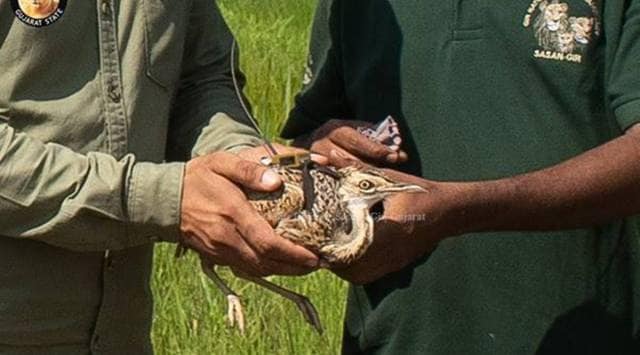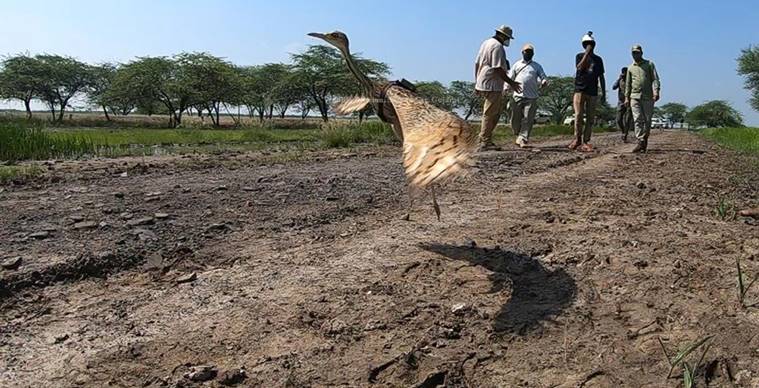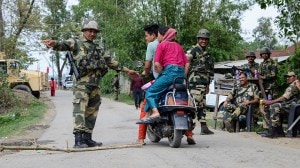- India
- International
Female lesser florican of the pair tagged in Bhavnagar takes off to Telangana
The revelation substantiates observations and findings of ornithologists such as late Dharmakumarsinhji that these birds migrated to peninsular India from the western part after the breeding season.
 The female lesser florican after being tagged in Velavadar, Bhavanagar, in September this year. (Photo courtesy: Gujarat state forest department)
The female lesser florican after being tagged in Velavadar, Bhavanagar, in September this year. (Photo courtesy: Gujarat state forest department)One of the two lesser florican birds tagged by the Gujarat forest department in the Blackbuck National Park (BBNP), Velavadar, in Bhavnagar district in September this year, has flown all the way to Telangana and has been camping there.
The revelation substantiates observations and findings of ornithologists such as late Dharmakumarsinhji that these birds migrated to peninsular India from the western part after the breeding season.
“The tagged male florican is camping near Velavadar. But the female has flown away to Telanagana and has been camping there,” a source privy to the development told The Indian Express.
Lesser floricans are the smallest birds in the bustard family and were once endemic to the Indian sub-continent. But a survey by the Wildlife Institute of India (WII) in 2017-18 estimated the population of these birds to be around just 240 males and an equal number of females.
The Status of the Lesser Florican, Survey Report 2017-18 of the WII noted that it suggested a population decline of 81 per cent over just three to four generations. In 1999, a survey by Ravi Shankar had estimated 3,550 individuals spread across 1,786 male territories. The 2017-18 survey by the WII recorded only 340 male territories of these birds.

The population of this agro-grassland bird has been declining mainly due to habitat loss, say experts. The red list of the International Union for Conservation of Nature puts this species in the endangered category. This bird is also part of the Endangered Species Recovery Programme of Dehradun-based WII. Lesser floricans are found in states like Gujarat, Rajasthan, Madhya Pradesh, Maharashtra, Andhra Pradesh, Telangana etc.
The Sasan wildlife division under the Junagadh wildlife circle of the state forest department had launched a project to study movements and habitat use of lesser florican during breeding and non-breeding season. As part of the project, the department had tagged one male florican and a female florican between September 1 and 5 this year. The tags are satellite-linked solar-powered platform transmitter terminals (PTTs).
The project is supervised by Mohan Ram, deputy conservator of forests (DCF) of Sasan wildlife division. The DCF confirmed the development to The Indian Express but did not divulge further details saying the study was still on. A press release issued by the DCF of Sasan wildlife division announcing the launch of the project stated that the global population of lesser florican is estimated to be less than 700 individuals.
 The male lesser florican. (Photo courtesy: Gujarat state forest department)
The male lesser florican. (Photo courtesy: Gujarat state forest department)
Dharmakumarsinji had ringed 498 lesser floricans between 1945 and 1950 and recovered around 10 per cent of them. His study surmised that lesser floricans fly back to southern India after breeding in western India during the monsoon in July-September.
The WII survey concluded that BBNP was the second most important habitat of lesser florican with respect to conservation of this species. Besides Velavadar in Bhavnagar, lesser floricans are sighted in Kutch, Amreli and Dahod districts of Gujarat. However, Velavadar is considered their prime breeding site in the state.
Officers of BBNP say that lesser floricans start becoming more visible from June-July as their breeding season begins and their sighting starts declining from September-October onwards as the breeding season ends with the retreat of the south-west monsoon. These birds remain visible largely during their breeding season only as jumping display of courtship by the male give away their presence. Females are elusive and their camouflage make it even tougher to spot them in grasslands.
Yadvendradev Jhala, dean of Wildlife Institute of India said the telemetry data of the flight of the first-ever tagged lesser florican was very interesting. “Floricans are small birds and the tags till now were too heavy to be put on these birds. It’s for the first time that a female was tagged. Earlier, only males had been tagged. The three male birds that WII had tagged had gone to Madhya Pradesh, Maharashtra and Andhra Pradesh as well. But they had done lots of stopovers. They would stay for 15 days or 20 days at one place, then hop again and do a 100 to 200 kilometre flight and then again wait for a few days. This female has taken a direct route which is very interesting,” said Jhala.
The WII scientist further said that the project would also throw light on how female floricans differ from males. “Females differ a lot in their behaviour and requirements so it’s possible they migrate to different places. But we don’t know that. But yes, we do know that they congregate for breeding during the monsoon in Rajasthan, Gujarat and parts western Madhya Pradesh. What happens after the breeding season, we don’t know. This is the beginning of the study so, this (flight) is the tip of the iceberg. Once more birds are tagged, we would know more about their ecology,”
The scientist added that it was also interesting that the male had stayed put in the breeding area even after the breeding season and that we had had telemetry data of it for the first time.
Professor Indra Gadhvi, head of the Department of Marine Science at the Maharaja Krishnakumarsinhji Bhavnagar University, Bhavnagar, and who was part of the WII survey as well as the team which tagged the floricans this September, said more data were needed for the study.
“I do not have any data about the flight of the female… both males and females have been sighted in Velavadar as well as in Kutch even during April-May, which is not their breeding season,” Prof Gadhvi said.
Apr 27: Latest News
- 01
- 02
- 03
- 04
- 05








































